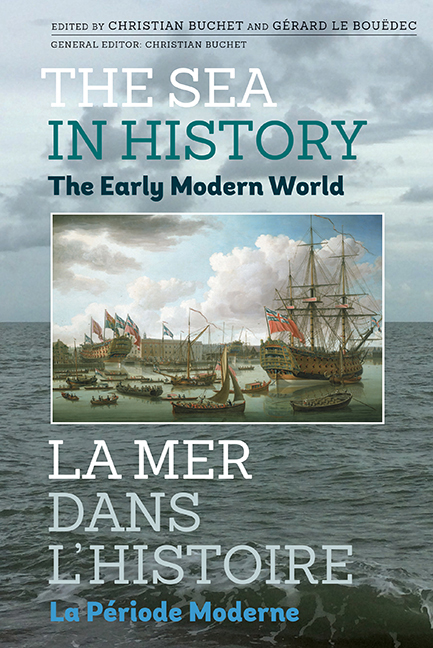Book contents
- Frontmatter
- Contents
- List of Illustrations
- List of Contributors
- Introduction générale et remerciements par
- General introduction and acknowledgements
- Introduction (français)
- Introduction (English)
- LA RÉUSSITE PAR LA MER:La reussite par la mer des territoires et des communautés littorales
- La construction d'un espace mondial: La circulation maritime et les ports
- La forte croissance de l'économie des pêches et des échanges
- Les acteurs de la dynamique maritime
- LA PUISSANCE MARITIME INSTRUMENT DE LA PUISSANCE POLITIQUE ET D'UNE STRATÉGIE GLOBALE DE RAYONNEMENT VOIRE DE DOMINATION: Les puissances maritimes occidentales
- L'ordre des Hospitaliers de Saint-Jean de Jérusalem, Rhodes et Malte, puissance maritime
- Portugal, the west seafront of Europe
- Les formes complexes de la prédominance de l'Espagne, première puissance mondiale de l'histoire
- Le maritime, fondement de la prédominance commerciale et économique des Provinces-Unies
- The keys to British success: trade as a motor and sea as a centre
- Le modèle français: la recherche par l'état de la prédominance maritime, réussites et échecs
- L'Europe Centrale et la mer à l'époque moderne
- Swedish and Danish rivalry to become great powers seen through the development of naval and merchant fleets
- Ambiguous relations between Russia and the sea: causes and consequences
- L'océan Indien, entre convoitises et indifférences
- Les puissances maritimes asiatiques
- L'Afrique
- La politique maritime et l'idéologie
- Mer et développement technologique
- Développement maritime et maîtrise économique et financière
- Développement maritime et maîtrise organisationnelle
- Conclusion (français)
- Conclusion (English)
- Conclusion générale par
- General conclusion by
- Miscellaneous Endmatter
- Miscellaneous Endmatter
Ambiguous relations between Russia and the sea: causes and consequences
from LA PUISSANCE MARITIME INSTRUMENT DE LA PUISSANCE POLITIQUE ET D'UNE STRATÉGIE GLOBALE DE RAYONNEMENT VOIRE DE DOMINATION: Les puissances maritimes occidentales
Published online by Cambridge University Press: 11 May 2017
- Frontmatter
- Contents
- List of Illustrations
- List of Contributors
- Introduction générale et remerciements par
- General introduction and acknowledgements
- Introduction (français)
- Introduction (English)
- LA RÉUSSITE PAR LA MER:La reussite par la mer des territoires et des communautés littorales
- La construction d'un espace mondial: La circulation maritime et les ports
- La forte croissance de l'économie des pêches et des échanges
- Les acteurs de la dynamique maritime
- LA PUISSANCE MARITIME INSTRUMENT DE LA PUISSANCE POLITIQUE ET D'UNE STRATÉGIE GLOBALE DE RAYONNEMENT VOIRE DE DOMINATION: Les puissances maritimes occidentales
- L'ordre des Hospitaliers de Saint-Jean de Jérusalem, Rhodes et Malte, puissance maritime
- Portugal, the west seafront of Europe
- Les formes complexes de la prédominance de l'Espagne, première puissance mondiale de l'histoire
- Le maritime, fondement de la prédominance commerciale et économique des Provinces-Unies
- The keys to British success: trade as a motor and sea as a centre
- Le modèle français: la recherche par l'état de la prédominance maritime, réussites et échecs
- L'Europe Centrale et la mer à l'époque moderne
- Swedish and Danish rivalry to become great powers seen through the development of naval and merchant fleets
- Ambiguous relations between Russia and the sea: causes and consequences
- L'océan Indien, entre convoitises et indifférences
- Les puissances maritimes asiatiques
- L'Afrique
- La politique maritime et l'idéologie
- Mer et développement technologique
- Développement maritime et maîtrise économique et financière
- Développement maritime et maîtrise organisationnelle
- Conclusion (français)
- Conclusion (English)
- Conclusion générale par
- General conclusion by
- Miscellaneous Endmatter
- Miscellaneous Endmatter
Summary
ABSTRACT. The history of Russia illustrates the impact of the sea on the rise or decline of a nation. As long as Sweden and the Hanseatic League were blocking Russia from accessing the Baltic Sea to trade, the country was not able to develop economically. In this way, contrary to the traditional scheme, which sees the fishing industry develop, then trade, and finally a navy to protect all these traffics; in Russia, it was first the creation of a navy by Tsar Aleksey Mikhailovitch (1645–1676) and above all by Peter the Great (1682–1725) that allowed Russia to develop economically through trade and to reach, on both military and diplomatic levels, the status of a great nation.
RÉSUMÉ. L'histoire de la Russie illustre bien l'impact de la mer dans le développement ou le déclin d'une puissance. Tant que la Suède et la Ligue hanséatique, notamment, empêchèrent la Russie d'avoir accès au commerce de la mer Baltique, le pays ne fut pas en mesure de se développer économiquement. Ainsi, contrairement au schéma classique, qui voit successivement apparaître un développement de la pêche, puis du commerce et, enfin, une marine de guerre pour protéger l'ensemble de ces flux ; en Russie, c'est l'instauration en premier d'une marine de guerre, avec le tsar Aleksey Mikhailovitch (1645-1676) et surtout Pierre le Grand (1682-1725) qui permit à la Russie de connaître le développement économique généré par le commerce, et d'atteindre au plan militaire comme diplomatique le statut de grande puissance.
The history of Russia illustrates well the role that the world's oceans play in the rise and fall of international powers. History shows that the neighboring countries tried to exploit the limitations and remoteness of Russia from the world trade routes. One can learn a lot from studying how Russia managed to resolve this problematic situation.
Russian military and merchant ships, the so-called lad'ya, entered the Baltic Sea in the 9–10th century AD. Folktales have been recorded about the rich merchants Sadko and Solovey Boudimovich. They were trading from Novgorod with the Upper Volga region and the Reval port (modern Tallinn, in the folktale called “Ledenets,” from Estonian “Lindanisa”).
- Type
- Chapter
- Information
- The Sea in History - The Early Modern World , pp. 509 - 526Publisher: Boydell & BrewerPrint publication year: 2017



